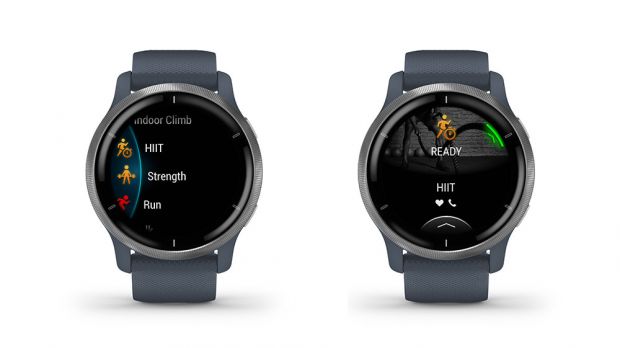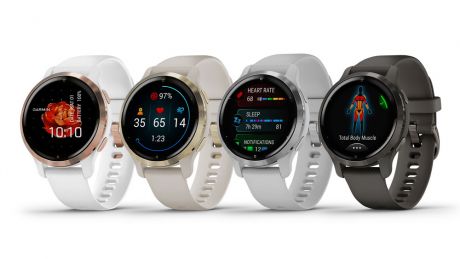You can trust Coach
Garmin’s reputation for making top-quality sports watches was well established before the arrival of the original Venu – but that was the device that signalled a serious move towards making attractive fitness smartwatches. The Venu broadly succeeded by putting Garmin’s sports tracking in a more desirable-looking watch with a vibrant and colourful AMOLED touchscreen, while still offering three to four days of battery life. It had some worthwhile smart features too, including music storage and proper Spotify integration (Fitbit’s smartwatches remain glorified remote controls), Garmin Pay and the Connect IQ app store, though the latter is limited compared with the Apple or Google app stores.
With the Venu 2, Garmin hasn’t strayed too far from the formula of the original, but has made some useful improvements. There are new health-tracking capabilities, like more in-depth sleep tracking and fitness age, which brings a metric buried in the Garmin Connect app to the watch.
Admittedly Fitness Age on the Venu 2 is also buried two menu screens deep, where you’ll also find your VO2 max score, but we’re hoping a widget – or “glance” as they’re called on the Venu – will turn up in time.
There’s also a new health snapshot mode, which asks you to sit still for two minutes then returns information on your heart rate, heart rate variability, blood oxygen saturation, stress levels and respiratory rate.
These new measurements are backed up by a new generation of Garmin’s Elevate heart rate sensor. The Elevate 4 intends to increase the accuracy of the optical heart rate tracking and pulse oximeter readings, but we found the improvements on these fronts to be fairly small.
The watch also introduces new workout modes, of which the most impressive is a HIIT training mode that includes preset timers for common HIIT sessions like Tabata, EMOM (every minute on the minute) and AMRAP (as many rounds/reps as possible). You can also download guided HIIT workouts, plus others like strength, Pilates and yoga sessions, from Garmin Connect to the watch and get on-screen animations to show you how to do the moves.

One feature I was pleased to see on the Venu 2 was an improvement in battery life. It’s listed as lasting up to 11 days in smartwatch mode (eight hours GPS plus music), compared with five days (six hours GPS plus music) for the original Venu.
However, in practice I’ve not seen a drastic improvement. With the always-on screen activated and exercising outdoors a lot I had to charge it every three to four days. That was also with the screen set to medium brightness, and even switching that to low mostly just got me four days.
I track outdoor activities with the GPS most days, which does hit the battery life hard, so you could probably get up to a week with runs or cycles every other day, especially with the always-on screen set to off. However, I still can’t see how the Venu 2 could last 11 days.
A legitimate battery improvement is the new fast charge feature, which means 10 minutes of charging nets you a full day in watch mode, or one hour of GPS plus music.
The Venu 2 comes in two sizes: the standard 1.3in (35mm) – larger than the original’s 1.2in (33mm) – and the Venu 2S at1.1in (28mm). The Venu 2S’s smaller size also means it has a shorter battery life than the Venu 2 at 10 days (seven hours GPS plus music), although both new watches have increased the storage available for music from 500 songs to 650.
I’ve also noticed a general improvement in the software on the Venu 2, which makes more use of the colourful screen than the original watch. The better graphics for everything from your widgets to the list of sports modes provides a more engaging experience.
In sports modes like running, the screen becomes very basic, with white numbers on a black background. When you set the screen to always-on this applies to activities, too. However, the screen is pretty dull until you turn it towards you and on my first run with the Venu 2 in bright sunshine, it was impossible to read my stats until I turned my wrist and waited for it to brighten automatically. The gesture-to-wake function is pretty snappy, but it’s not quite as easy to see your stats on the go as it is with either a normal sports watch or a brighter always-on display like the Apple Watch’s.
I had high hopes for the accuracy of the Venu 2’s heart rate tracking. The first run I did with it – a track session doing 8 x 1km reps – only raised those hopes further since the monitor tracked the rises and falls of my heart rate closely in line with a chest strap.

However, since then the Venu 2 has regressed to more or less the standard level of accuracy I get from an optical monitor worn on the wrist, which is to say not great. I’d regularly have inexplicable spikes or drops in my heart rate during runs and other activities, which threw off my average and max readings for workouts. You can link up an external monitor via either Bluetooth or ANT+ and this will be worthwhile if you’re interested in using your heart rate to guide your exercise.
The Venu’s GPS accuracy seems to be a tad generous compared with other watches, including other Garmins I’ve tested it against. However, it’s generally within the margin of error and I think it’s OK for distance accuracy. For a regular track runner like me it’s disappointing that the Venu 2 doesn’t have Garmin’s Track Run sports mode, which does produce more accurate results by locking on to the track.
The Venu 2 features the improved sleep tracking that was brought to watches like the Garmin Fenix 6 last year, which includes a sleep score plus more details about your night’s rest on the watch itself. The data is well presented with a quick snapshot rating of your night plus a little more depth if you want it, but like pretty much all other Garmin’s I’ve tested, the Venu 2 consistently overestimated how much I’d slept. Periods spent watching TV or reading before dropping off are often given as light sleep, and it would sometimes miss the times my daughter woke me up in the night too.
See related
- How To Buy The Best Garmin Fitness Tracker For You
- The Best Fitness Smartwatches
- The Best Fitness Trackers Of 2021

This data feeds into the Body Battery score on the watch, which gives a simple rating out of 100 for how much energy you have, based on stuff like your activity, sleep and heart rate. It’s a nice idea but undermined a little by the optimistic sleep tracking, which consistently had my Body Battery recharging to 100 even on nights where I slept poorly.
While it’s not a bona fide smartwatch like the Apple Watch, mainly because the Connect IQ app store contains very few apps, the Venu 2 does have all of Garmin’s smartest features on board. This includes music storage and the ability to link up with streaming services including Spotify, so subscribers to those services can sync playlists over and listen to them offline, plus contactless payments through Garmin Pay. You also get weather forecasts and smartphone notifications, and while on iOS these notifications are one-way, you can set up some replies to use on the watch if it’s paired with an Android phone.
Like its predecessor, the Venu 2 is an attractive watch that brings Garmin’s sports tracking to a more appealing device, with an AMOLED screen that’s a pleasing upgrade on the standard sports watch display. It’s a modest update on the original, though even a little extra battery life is always welcome and the new HIIT mode is well done.
However, one unwelcome change with the new watch is an increase in price. The Garmin Venu 2S costs £349.99 and the larger Venu 2 is £399.99, while the Venu is £329.99. This is despite the Venu 2’s inferior battery life and ease of use during activity compared with a sports watch like those in the Forerunner range. It’s also worth stating that the Venu 2 is no smarter than the original with regard to apps, where true smartwatches like the Apple Watch Series 6 (from £379) leave it well behind.
Buy from Garmin | £349.99-£399.99

Nick Harris-Fry is a journalist who has been covering health and fitness since 2015. Nick is an avid runner, covering 70-110km a week, which gives him ample opportunity to test a wide range of running shoes and running gear. He is also the chief tester for fitness trackers and running watches, treadmills and exercise bikes, and workout headphones.

